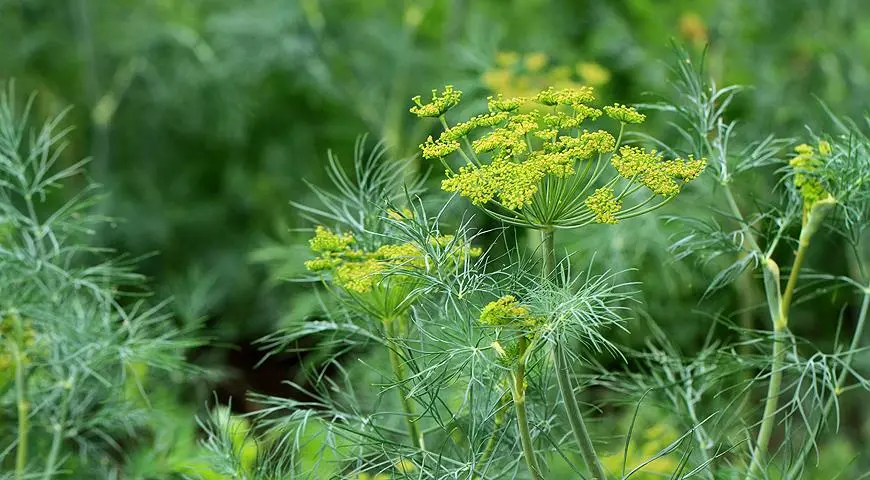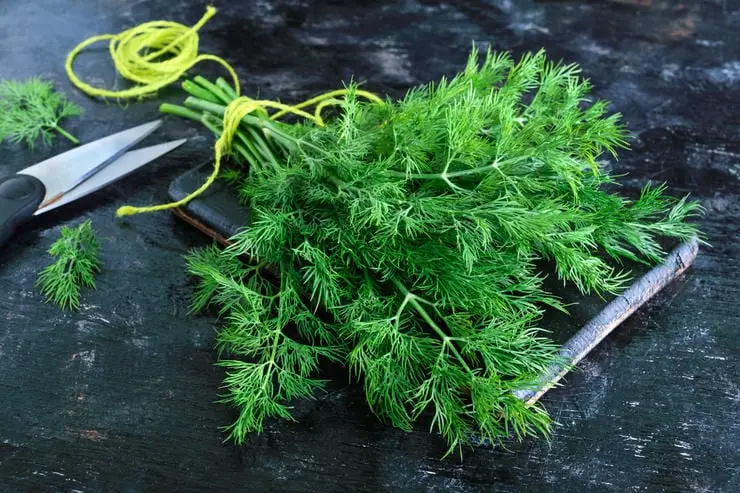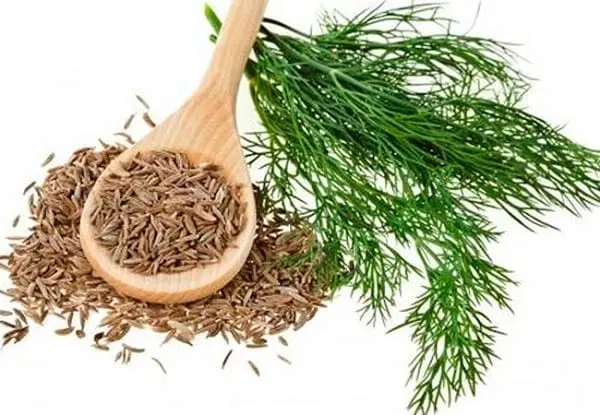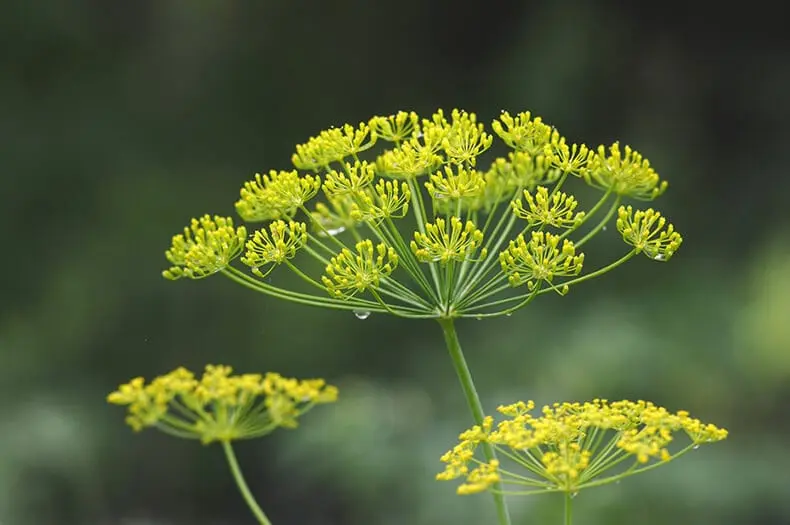Contents
Description
Dill is greens familiar to many people from childhood with has a spicy aroma and a rich set of minerals.
Dill belongs to the annual herbaceous plants of the umbrella family, like cilantro and parsley. Dill can be seen in the wild in southwestern and central Asia, Iran, North Africa and the Himalayas. As a garden plant, dill is found on all continents.
This spring greens are in great demand with us: with it, any dish becomes more aromatic and tasty. Although foreigners, spoiled by Provencal herbs all year round, do not share this passion and believe that dill clogs the taste of any food.
A plant with a strong spicy aroma, dill is used in cooking both fresh and dried or salted. Dill is added when canning tomatoes, cucumbers, peppers, mushrooms – it not only gives a special aroma, but also protects vegetables from mold.
It is also used to make vinegar or various spice mixtures. Greens are served with hot and cold meat and fish dishes, soups, borscht, vegetables and salads. Crushed dill seeds are added to the tea for flavor.
Composition and calorie content
The fruits of dill contain 15-18% fatty oil and 14-15% proteins. The fatty oil contains petroselinic acid (25, 35%), oleic acid (65, 46), palmitic acid (3.05) and linoleic acid (6.13%).
- Caloric content 40 kcal
- Proteins 2.5 g
- Fat 0.5 g
- Carbohydrates 6.3 g
- Dietary fiber 2.8 g
- Water 86 g
Dill is rich in vitamins and minerals such as: vitamin A – 83.3%, beta-carotene – 90%, vitamin C – 111.1%, vitamin E – 11.3%, vitamin K – 52.3%, potassium – 13.4%, calcium – 22.3%, magnesium – 17.5%, phosphorus – 11.6%, cobalt – 34%, manganese – 63.2%, copper – 14.6%, chromium – 40.6 %
The benefits of dill

Dill contains iron, potassium, calcium, phosphorus, vitamin C, carotene, folic and nicotinic acids, carotene, thiamine, riboflavin, flavonoids, pectin substances, a set of mineral salts. Dill fruit contains a healthy fatty oil that is rich in important acids.
Dill is useful for the proper functioning of the gastrointestinal tract, it can reduce blood pressure and normalize cardiovascular activity. Dill seeds are brewed for small children with signs of intestinal colic, dill relieves pain in cystitis and has a diuretic effect. It also stimulates milk production in nursing mothers, relieves headaches and calms the nervous system.
Dill is well stored in dried and frozen form, so you can enjoy its aroma almost all year round – as long as there are enough preparations. In cooking, dill is used for pickling and salting, added to marinades and snacks, first and second courses.
Dill is recommended for obesity, kidney, liver and gallbladder diseases.
Dill is also advised to eat for insomnia. However, dill is not recommended for people with low blood pressure.
Dill harm

Dill is perhaps the healthiest product. He has only one contraindication – hypotension, that is, low blood pressure. This is a consequence of its ability to relieve pressure. And even then, if you do not get carried away with eating dill, it will not hurt hypotensive patients.
There is also individual intolerance, but no cases of allergy to dill have been recorded. So, in fact, only those few who for some reason do not like the taste do not eat it.
Dill in cosmetology
Dill is a good antiseptic and bactericidal agent, prepared on the basis of dill tincture, they wipe the face, which is characterized by acne or clogged pores. You can make lotions or steam dill baths.
To reduce skin pigmentation, chopped dill is poured with boiling water or masks are made from dill and sour cream. A mixture of dill and grated cucumber will help to remove black circles under the eyes and fine wrinkles.
Dill in the cosmetics moisturizes the skin and makes it radiant and fresh.
Dill in cooking

Dill is one of the most popular spices for culinary experts around the world. Used herbs and dill seeds, as well as essential oil.
Dill is used for pickling and pickling cucumbers, tomatoes, zucchini …, mushrooms, fish. Dill pickles, marinades, sauces are delicious and make you feel better.
Dill greens are usually added to hot dishes at the final stage – in soups, main courses, side dishes.
In Scandinavia, dill is widely used in the preparation of fish and seafood dishes. Fresh dill gives a great flavor to fresh vegetable salads, just like any salad.
Dill is good in combination with dairy products, great in pie fillings. When adding dill to dishes, keep in mind that it reduces the salt content.
Dill is included in dry form in many spice mixes: Bologna Spice Blend, Curry Spice Blend, Hop-Suneli Spice Blend, Frankfurt Spice Blend.
Dill seeds are used for flavoring confectionery, making aromatic vinegar and oil. Used in marinades, soups.
Medical use

Dill has many beneficial properties due to the substances it contains:
Carotene, carbohydrates, vitamins (C, B, PP, folic, ascorbic acid), flavonoids, minerals (iron, potassium, calcium, phosphorus salts), essential oil (carvone, fellandrene, limonene).
Cucumber pickle, which helps with withdrawal symptoms, is so good thanks to the essential oils of dill.
Preparations made from dill are taken for hypertension – a large amount of dill can greatly reduce pressure, up to weakening of vision and fainting. Therefore, people with low blood pressure need to be careful when consuming large amounts of dill.
- Dill is used for salt deposition, obesity, diabetes.
- Dill decoction helps with eye inflammation and conjunctivitis.
- Dill is considered a sedative, eliminates insomnia, and is used for neuroses.
Preparations made from dill are used for angina pectoris and coronary insufficiency. It is also believed that dill improves kidney and liver function, regulates bile, helps with coughing, and eliminates hiccups.









